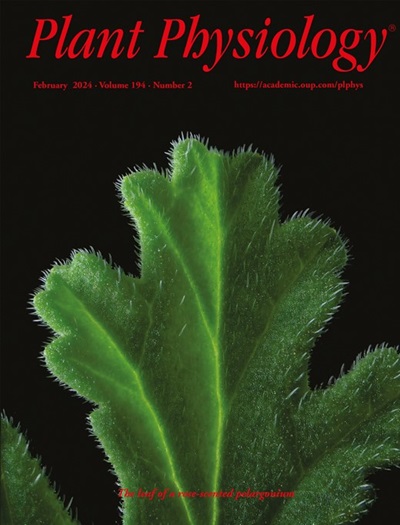Characterization of the cyclic dipeptide cyclo(His-Pro) in Arabidopsis
IF 6.5
1区 生物学
Q1 PLANT SCIENCES
引用次数: 0
Abstract
Diketopiperazines (DKPs) are chemically and functionally diverse cyclic dipeptides associated primarily with microbes. Few DKPs have been reported from plants and animals; the best characterized is cyclo(His-Pro), found in the mammalian central nervous system, where it arises from the proteolytic cleavage of a thyrotropin-releasing tripeptide hormone. Herein, we report the identification of cyclo(His-Pro) in Arabidopsis (Arabidopsis thaliana), where its levels increase upon abiotic stress conditions, including high salt, heat, and cold. To screen for potential protein targets, we used isothermal shift assays (iTSA), which examine changes in protein melting stability upon ligand binding. Among the identified proteins, we focused on the glycolytic enzyme, cytosolic glyceraldehyde-3-phosphate dehydrogenase (GAPC1). Binding between the GAPC1 protein and cyclo(His-Pro) was validated using nano differential scanning fluorimetry (nanoDSF) and microscale thermophoresis (MST), and we could further demonstrate that cyclo(His-Pro) inhibits GAPC1 activity with an IC50 of approximately 200 μM. This inhibition was conserved in human GAPDH. Inhibition of glyceraldehyde-3-phosphate dehydrogenase activity has previously been reported to reroute carbon from glycolysis towards the pentose phosphate pathway. Accordingly, cyclo(His-Pro) supplementation augmented NADPH levels, increasing the NADPH/NADP+ ratio. Phenotypic screening revealed that plants supplemented with cyclo(His-Pro) were more tolerant to high salt stress, as manifested by higher biomass, which we show is dependent on GAPC1/2. Our work reports the identification and functional characterization of cyclo(His-Pro) as a modulator of glyceraldehyde-3-phosphate dehydrogenase in plants.拟南芥中环二肽环(His-Pro)的表征
二酮哌嗪(DKPs)是一种化学上和功能上多样化的环二肽,主要与微生物有关。据报道,植物和动物很少发生dkp;最具特征的是环状(His-Pro),在哺乳动物中枢神经系统中发现,它是由促甲状腺激素释放三肽激素的蛋白水解裂解产生的。在这里,我们报告了在拟南芥(拟南芥)中鉴定的环代蛋白(His-Pro),其水平在非生物胁迫条件下增加,包括高盐、高温和低温。为了筛选潜在的蛋白质靶点,我们使用了等温移位法(iTSA)来检测配体结合时蛋白质熔化稳定性的变化。在鉴定的蛋白质中,我们重点研究了糖酵解酶,胞质甘油醛-3-磷酸脱氢酶(GAPC1)。利用纳米差示扫描荧光法(nanoDSF)和微尺度热泳法(MST)验证了GAPC1蛋白与cyclo(His-Pro)的结合,并进一步证明cyclo(His-Pro)抑制GAPC1活性的IC50约为200 μM。这种抑制作用在人GAPDH中是保守的。甘油醛-3-磷酸脱氢酶活性的抑制已被报道将碳从糖酵解转向戊糖磷酸途径。因此,cyclo(His-Pro)的补充增加了NADPH水平,增加了NADPH/NADP+比值。表型筛选显示,添加了cyclo(His-Pro)的植株对高盐胁迫的耐受性更强,表现为更高的生物量,我们认为这取决于GAPC1/2。我们的工作报告了环(His-Pro)作为植物甘油醛-3-磷酸脱氢酶调节剂的鉴定和功能表征。
本文章由计算机程序翻译,如有差异,请以英文原文为准。
求助全文
约1分钟内获得全文
求助全文
来源期刊

Plant Physiology
生物-植物科学
CiteScore
12.20
自引率
5.40%
发文量
535
审稿时长
2.3 months
期刊介绍:
Plant Physiology® is a distinguished and highly respected journal with a rich history dating back to its establishment in 1926. It stands as a leading international publication in the field of plant biology, covering a comprehensive range of topics from the molecular and structural aspects of plant life to systems biology and ecophysiology. Recognized as the most highly cited journal in plant sciences, Plant Physiology® is a testament to its commitment to excellence and the dissemination of groundbreaking research.
As the official publication of the American Society of Plant Biologists, Plant Physiology® upholds rigorous peer-review standards, ensuring that the scientific community receives the highest quality research. The journal releases 12 issues annually, providing a steady stream of new findings and insights to its readership.
 求助内容:
求助内容: 应助结果提醒方式:
应助结果提醒方式:


